Hydro-Raking
Overview: What the Hydro-Rake Does
2025: Hydro-Raking
2024: Hydro-Raking
2023: Hydro-Raking
2022: Hydro-Raking
2021: Hydro-Raking
2020: Hydro-Raking
2019: Hydro-Raking
2018: Hydro-Raking
2017: Hydro-Raking
2016: No Hydro-Raking
2015 Hydro-Raking
2014 Hydro-Raking
2013 Hydro-Raking
2010: No Hydro-Raking
2009 Hydro-Raking
2008: No Hydro-Raking
2007 Program
2006 Program
2005 Program
2004 Program
The hydro-rake removes nuisance aquatic vegetation and debris (leaf material and decaying matter) from individual beach-front areas. The Hydro-Rake is basically a back-hoe with a rake attachment, mounted on a paddle boat. The 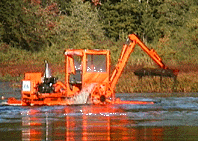 machine removes the roots and stems of nuisance aquatic vegetation up to a depth of 12 feet and can "clean" an average beach area 75 ft by 50 ft in approximately 1 to 2 hours, depending on the weed densities, depth and bottom characteristics. Removal of leaf litter, organic debris, or dense vegetation may require considerably more time.
machine removes the roots and stems of nuisance aquatic vegetation up to a depth of 12 feet and can "clean" an average beach area 75 ft by 50 ft in approximately 1 to 2 hours, depending on the weed densities, depth and bottom characteristics. Removal of leaf litter, organic debris, or dense vegetation may require considerably more time.
The hydro-rake has no on-board storage. Each rake load must be deposited on the shore at the water's edge, from where the property owner is responsible for hauling or trucking the material to a permanent, upland disposal site. The stuff can be used in your garden.
Hydro-raking is performed in accordance with an Order of Conditions issued by the Andover Conservation Commission. On Foster's Pond, individual owners of property in Andover do not need to apply for a permit in order to participate in the group program, but their sign-up forms MUST be included in a package of materials submitted for formal approval by the Andover Conservation Commission prior to the commencement of each year's hydro-raking.
We have used one contractor, Solitude Lake Management (formerly named Aquatic Control Technology), since we began hydro-raking in 1992.
If you have questions about hydro-raking, please e-mail Steve Cotton.
2025: Ten Shoreline Property Owners Sign Up
Hydro-raking started out under sunny skies and finished a couple of days later than expected after a few minor glitches - including illness, weather delays, and a mechanical failure.
Ten shoreline property owners - eight on the Main Pond and two on the Channel - signed up for a total of 38 hours. The list was approved by the Andover Conservation Commission on May 20,
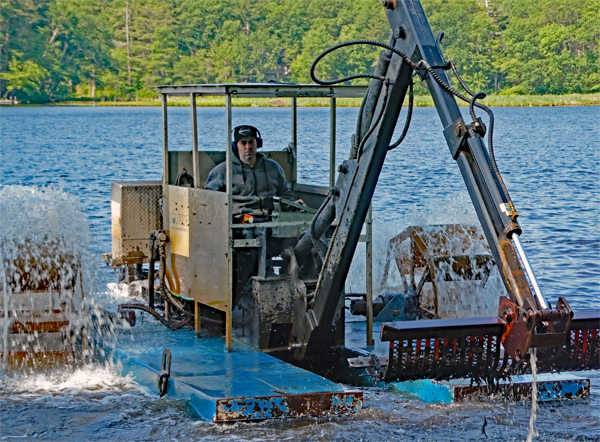
June 11: Solitude's Rob Hitrik performed most of the hydro-raking after being sidelined by an illness.
The hydro-rake was launched on June 2, but due to the illness of the assigned operator, hydro-raking didn't start until the following day.
The work was interrupted by lightning storms and an extended pause to replace bolts which snapped off a flange holding one of the paddle wheels. The hydro-rake departed on June 12.
2024: Seventeen Shorelines (A Record) Slated for Hydro-Raking
Hydro-raking got off to its earliest-ever start (April 1) with its largest-ever number of participants (seventeen). A torrential rainstorm interrupted the work for a day, but the operator got right back on schedule, putting in full days on Saturday and Sunday. He finished up on April 8.
The early start was driven by the Corporation's schedule for treating much of the Main Pond to combat fanwort, the Pond's most persistent invasive weed. The treatment, which was scheduled to begin in early May, requires spreading herbicide-infused clay pellets throughout the target area. The pellets sink to the bottom, where they slowly release the herbicide. The hydro-raking had to be completed before the pellets were applied. Otherwise, the hydro-rake would scoop them up and deposit them on shore, rendering them useless.
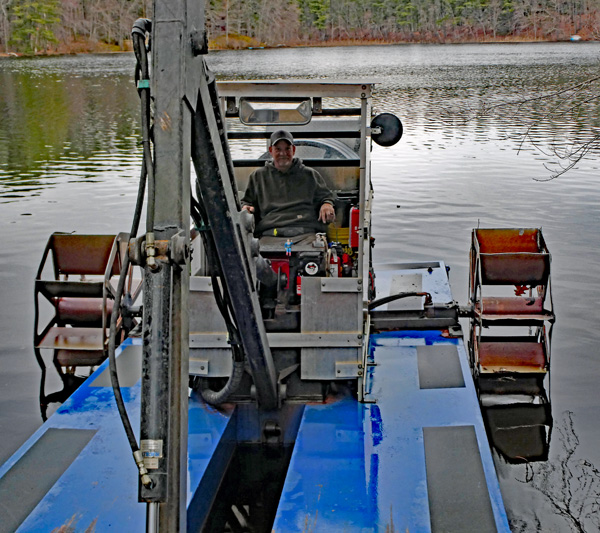
April 1: Greg Thompson, returning for a second year to operate the hydro-rake on Foster's Pond, adjusts the controls as he prepares to back away from the launch site on Willard Circle.
Participants requested a total of 55 hours of hydro-raking. Thirteen shorelines on the Main Pond and four along the Channel were on the list of 2024 sites approved by the Andover Conservation Commission on March 19.
2023: Hydro-Raking Targets 14 Shorelines
Fourteen shoreline property owners signed up for hydro-raking, the largest number in 20 years. In all, participants requested 71 hours of hydro-raking - more than in most previous years, but not by much.
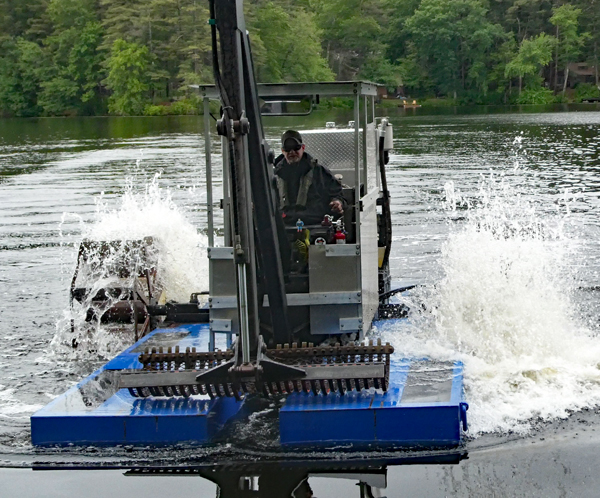
June 5: Greg Thompson guides one of the newest additions to the Solitude hydro-rake fleet across the Main Pond.
Eleven shorelines in the Main Pond, two in the Outlet Cove, and one in the Mill Reservoir appeared on the list of participants that was unanimously approved by the Andover Conservation Commission at a meeting on May 9. The hydro-rake arrived on the Pond on June 5 and finished its work on June 19.
2022: Hydro-Raking Starts for Six Shorelines
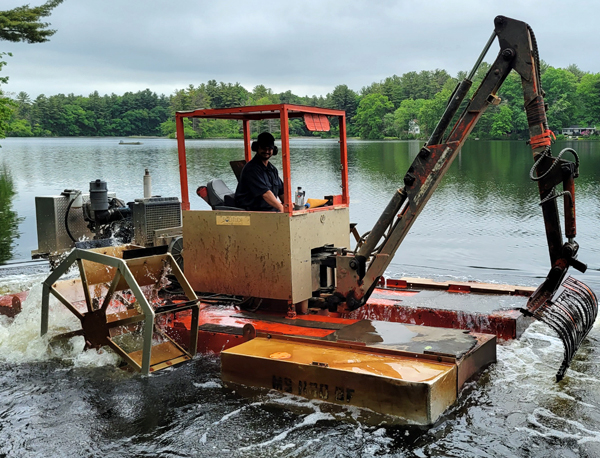
June 2: Hydro-raking gets underway in the Main Pond, with operator J.D. Afford at the controls.
Hydro-raking kicked off June 2 under cloudy skies and concluded June 7 under a bright sun, with only one minor glitch: the aging rig assigned for the job was too small to reach the spoils area at one shoreline, leaving the unlucky property unraked for the first time since hydro-raking began here in 1992.
In the end, five shorelines - four on the Main Pond and one on the Outlet Cove - were hydro-raked for a combined total of 36 hours.
The Andover Conservation Commission approved the 2022 list of hydro-raking participants on May 3.
2021: Hydro-Raking Beset by Delays
Hydro-raking was an excruciatingly tortuous process, delayed by work on the dam, interrupted by stormy weather, then delayed and interrupted repeatedly by the sudden departure of a hydro-rake operator.
The projec, whicht was supposed to begin and end in June, did not finish until August 4.
Originally scheduled to start in early June, hydro-raking was pushed back a couple of weeks when the 2020-21 winter drawdown was extended due to maintenance work on the dam. Replacement of the dam's spillway required keeping the water level too low for the hydro-rake to operate effectively.
Then, as the water rose, Solitude further delayed the start date due to its own scheduling conflicts.
The hydro-rake finally arrived on the Pond July 8, and work began the following day - only to be cut short as Tropical Storm Elsa took aim at New England.
Drenching rain put a temporary halt to the work, which was supposed to resume July 12 and take a week.
But Solitude's hydro-rake operator abruptly quit, leaving Solitude to bring in an operator from a job in Upstate New York. Once he arrived, he worked for a couple of days, but was then sent back to New York to complete that assignment.
After a number of further delays, the operator returned August 2 and completed work on Foster's Pond on August 4. By the time the job concluded, the aging hydro-rake was listing noticeably to port, the result of a leaky pontoon.
Twelve shoreline property owners originally signed up for hydro-raking, but one dropped out because of the delays. The remaining participants requested a total of 57 hours of raking. Eight of the properties were on the Main Pond, while the other three were on the Channel or the Outlet Cove. The 2021 list of hydro-raking participants was approved by the Andover Conservation Commission on May 18.
2020: Hydro-Raking, Delayed by Pandemic, Cleans Ten Shorelines
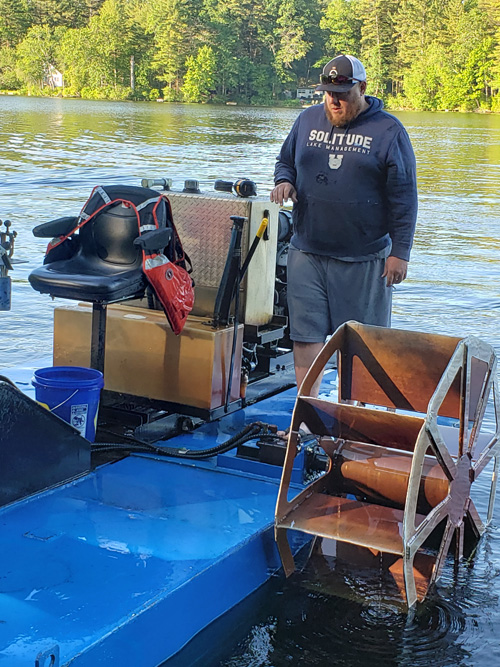
June 16: Hydro-rake operator Matt Lafrennie checks his gear prior to starting work in the Main Pond.
Hydro-raking got off to a late start after the Andover Conservation Commission (which must vote each year to OK the program) stopped holding meetings due to the coronavirus epidemic. But at the Commission's first-ever virtual meeting on May 26, Foster's Pond hydro-raking was Item #1 on the agenda, receiving unanimous approval. Hydro-raking of ten shoreline properties, eight of them on the Main Pond and two on the Outlet Cove, began on June 16. After 42.5 hours of hydro-raking over six days - most of it in withering heat and humidity - veteran operator Matt Lafrennie finished up on June 23.
2019: Ten Shoreline Properties Receive Hydro-Raking
Hydro-raking of 10 shoreline properties got underway April 22 and was completed a week later. Owners of the ten properties had requested a total of 35.5 hours of hydro-raking. The Andover Conservation Commission approved the list of participants on April 17.
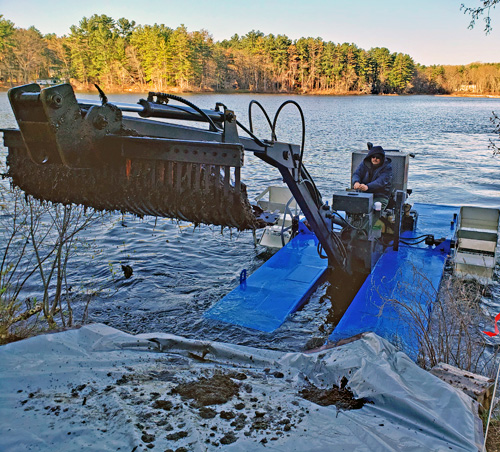
April 29: Hydro-rake operator Keith Wilson at work in the Main Pond during the final day of raking.
Almost all of the hydro-raking was requested in the Main Pond, where eight shoreline owners asked for 32.5 hours. One property at the mouth of the Channel and one Azalea Drive property accounted for the remaining three hours.
Thirteen shorelines were hydro-raked, the largest number since 2004. Nine properties in the Main Pond and four in the Outlet Cove were approved for hydro-raking by the Andover Conservation Commission on April 17, and the work got underway a week later.
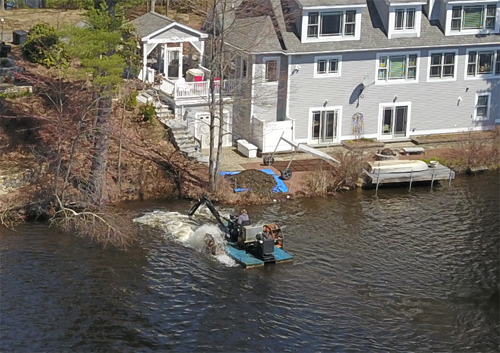
April 24: (Above) The hydro-rake goes to work in the Main Pond. Photo by Jim Cyrier. (Below) Operator Matt Lafrennie heads to shore with a load of leaves and twigs.
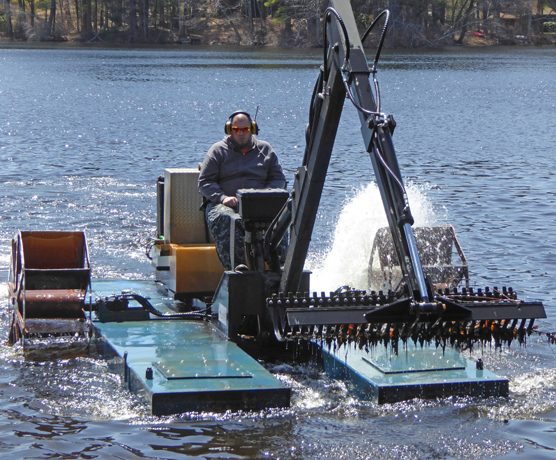
Under cloudless skies, hydro-raking began on April 24. Mother Nature threw wind and rain into the mix as the hydro-raking proceeded, but operator Matt Lafrennie just donned rain gear and kept going. The hydro-rake departed on May 3, after putting in 38 hours of work.
After a drought left the Pond too low to accommodate the hydro-rake in the Fall of 2016, a new schedule was developed for 2017.
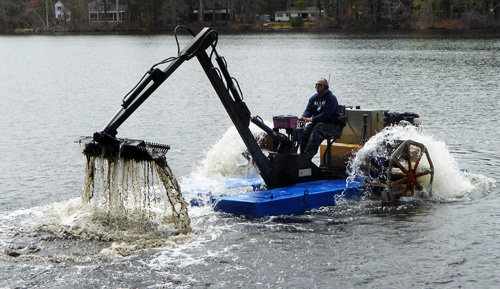
April 24: The machine employed in 2017 was smaller, faster, and more maneuverable. It had a narrower rake with the tines closer together, retaining more muck than the rake used in previous years.
Seven shoreline property owners - six on the Main Pond, one in the Outlet Cove - signed up for hydro-raking in April. In all, 18 hours of raking were performed, with the hydro-rake beginning its work April 24 and finishing on April 26.
After a series of spring rainfalls - and even a mid-April flood warning - the Pond was at its highest water mark in several years, making for easy access into shallow coves.
As a record-breaking drought reduced the mid-Summer water level to the lowest in memory, hydro-raking became a non-starter.
The rake must deposit spoils on the shore, above the high water mark, and with each passing day of dry weather, that shoreline got farther away from open water, beyond the rake's limited reach.
In consultation with the Corporation's lake management consultant, a plan was formulated to consider hydro-raking in the spring of 2017, as soon as the water level is restored.
After a mid-summer herbicide treatment sharply reduced weeds throughout the Pond, only six shoreline property owners signed up for hydro-raking.
All six of the shorefronts are located on the Main Pond. A total of 16.5 hours of raking were requested, barely above the minimum needed to bring the hydro-rake to the Pond.
Near-drought conditions over the summer slowed the work. With the Pond at lower-than-normal levels, the hydro-rake could not reach as far inland as usual to deposit spoils. In order to complete the requested work at some sites, the operator let the spoils piles settle overnight to form a more stable base, then resumed work the following day.
The Andover Conservation Commission gave its approval to the 2015 program on October 6. Raking began October 14 and finished on October 16.
Hydro-raking got underway on October 8, on a perfect New England fall day. The work concluded a week later, with the balmy weather continuing to hold.
Ten shoreline property owners had signed up for hydro-raking by the August 20 deadline. Six of the properties are located on the Main Pond, while the remaining four are on the Channel. In all, 25.5 hours of operating time were requested.
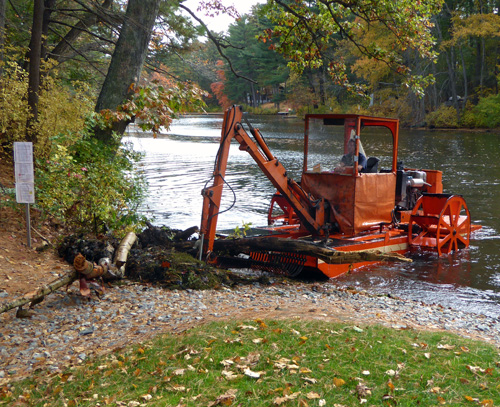
October 15: The hydro-rake, after clearing weeds at the dam, brings in the trunk of a birch tree that had been felled by beavers.
In addition, the Corporation commissioned an hour of raking at the dam to remove vegetation from the site of a small but persistent leak. That set the stage for the next phase of the repair job, bringing clay and crushed stone in to plug the leak. The rake also cleared a birch tree that had been felled recently by a beaver.
The Conservation Commission had unanimously approved the list of 2014 participants at its September 16 meeting. The formal vote was required before the work could commence.
Traditionally, hydro-raking has been scheduled on Foster's Pond in the Fall, to minimize the chances of an algae bloom and avoid interfering with swimming.
For the first time since 2009, the hydro-rake returned to Foster's Pond to remove muck and rooted vegetation along nine shoreline properties. The raking began on October 10 in the Main Pond, where five property owners had signed up for a total of 12 hours of operating time. Another two properties in the Channel and two in the Outlet Cove were raked for a total of eight hours. The work was completed on October 15.
The four-year gap in hydro-raking was largely the product of successful chemical weed treatments. The herbicidal treatments, although aimed at non-native plants, had reduced the growth of lilies, and many hydro-raking participants have used raking to carve a pathway through the lilies along their shorelines. With the temporary disappearance of some lily patches, the demand for hydro-raking fell off. In addition, low Fall water levels occasioned by near-drought conditions had in some years rendered hydro-raking impossible, since the rake must snuggle close to the shoreline to deposit spoils.
In 2013, however, the accumulation of organic debris from falling leaves and decaying weeds, the resilience of the lilies and the return of normal rainfalls all combined to spur renewed interest in hydro-raking.
Early in 2010, torrential rains left the Foster's Pond Dam in need of repairs. The water level in the Pond had to be lowered to undertake the work, which was completed in June. By then, a drought had settled in, and the water did not return to its normal level for the remainder of the summer. The Pond remained too shallow for the hydro-rake, which must be able to reach the shoreline to deposit each rakeful of muck.
Eight shoreside property owners participated in the 2009 hydro-raking program. Participants included five owners on the Main Pond, one on the Mill Reservoir, and two on the Channel. Collectively, they requested 20 hours of work, which was performed by Aquatic Control Technology. The Andover Conservation Commission approved the 2009 hydro-raking program on October 6. The work began to begin on October 19, and took three days.
With chemical weed treatments keeping most shorelines free of weeds in 2008, few Pond residents saw much need for hydro-raking. As a result, 2008 was a "bye" year for raking. Those residents who usually request hydro-raking were adopting a wait-and-see approach for 2009.
2007 Hydro-Raking Wraps Up
October 19, 2007
It began with flawless fall weather, and concluded under a cloudburst. The 2007 hydro-raking program spanned three days, and, for the first time ever, included properties bordering the Mill Reservoir.
As the first rays of the morning sun caught swirls of mist rising from the Pond, the hydro-rake chugged away from its Willard Circle launch site to begin three days of shorefront muck-removal.
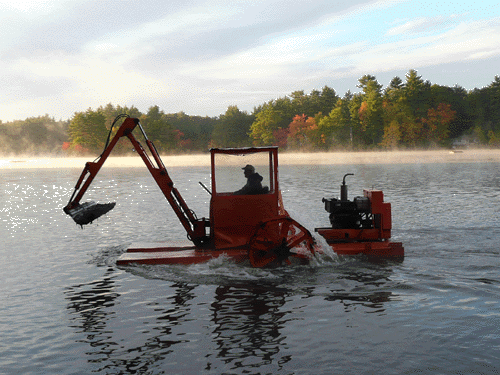
October 17: The hydro-rake brings up a rakeload of muck in the Main Pond, as mist blankets the surface in the distance.
Ten property owners signed up for the 2007 hydro-raking program. The list of participants was submitted to the Andover Conservation Commission, which must annually vote to okay the program before the rake can start its work.
Historically, the Conservation Commission has been very supportive of weed control efforts in Foster's Pond, and the annual vote to approve the hydro-raking has often taken less than a minute.
The 2007 vote proved no exception. At an evening meeting on October 16, the Commission unanimously endorsed the program. The vote came at about 9:30 p.m. In anticipation of the favorable vote, long-time hydro-rake operator Craig Hadley had launched the craft into the Pond earlier in the day. That meant he was ready to go at sunrise the next morning, and the first rakeload of muck came up at 7 a.m.
This year's participants included five owners on the Main Pond, three on the Channel, and - for the first time since hydro-raking started in 1992 - two on the Mill Reservoir. Together, they received a total of 25.5 hours of raking. Although the list of participants changes from year to year, the level of activity has remained fairly constant for the last three years.
The raking began in the Main Pond on October 17, moved to the Channel the following day, and ended in the Mill Reservoir around 1 p.m. on October 19. Lower-than-normal water levels presented something of a challenge in a couple of locations, making it difficult to maneuver the rake close to shore.
Hydro-Raking Starts (and Ends) Under Sunny Skies
October 13, 2006
The hydro-rake - which began its work in the main Pond October 10 under cloudless skies - was hauled out on October 13 in similarly picture-perfect weather.
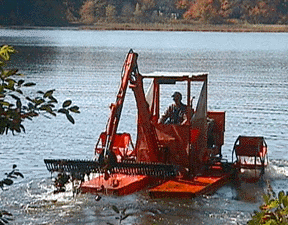 |
Hydro-rake begins working in the main Pond, October 10, 2006 |
Long-time hydro-rake operator Craig Hadley launched the ungainly craft from Willard Circle into glass-smooth waters around 10 a.m. on October 10. The first rakeful of muck came up shortly before noon.
Nine shorefront property-owners and the Foster's Pond Corporation signed up for a total of 26.5 hours of raking for Fall 2006. The list of properties included five on the main Pond and four in the Channel, plus a small amount of raking around the dam.
The list must be approved by the Conservation Commission each year. The Commission unanimously approved the 2006 list of participants at a meeting on September 19. Annual approval has become a routine matter, and 2006 was no exception.
The hydro-rake began its work in the Main Pond, moving to the Channel on Day 2. The work was finished on October 12, but the rake wasn't hauled from the pond until the following day.
Three Days of the Hydro-Rake:
2005
October 2005
The hydro-rake began its work on shorefront properties in the main Pond
on October 11, with three days sufficing to finish this year's
scheduled program.
The rake was launched from Willard Circle on Columbus Day.
It took a little more than an hour the following morning for the
operator to
fuel the craft and put up its rain flaps. The first load of
muck came up from the bottom shortly before 8 a.m.
The rake finished its work in the main Pond in one
day. Work in the channel started early in the morning on Day
2. The third and final day of raking was to conclude
with a sweep of the Foster's Pond Dam.
On September 20, the Andover Conservation Commission
unanimously approved this year's hydro-raking program for Foster's
Pond. Ten shorefront owners - plus the Foster's Pond Corporation
- signed up for hydro-raking this Fall.
With fanwort gone from their shorelines, most property
owners put the hydro-rake on hold this year, but some saw an
opportunity to make a bigger-than-ever impact on lilies and muck.
Four owners on the main Pond, and six on the channel,
arranged for their properties to be raked this year, for a total of
24.5 hours. In addition
the Corporation signed up for a half hour of weed removal near the
dam. Last year, 13
participants had 29 hours
of work done.
Although the results of the Sonar treatment have been
dramatic, the lilies are going to bounce back next year, according to
Marc Bellaud, senior biologist at Aquatic Control Technology.
Shoreline owners who want to get rid of lily roots, leaf
litter and muck still need to rely on hydro-raking. And this
year, with lily growth impeded by the Sonar, each hydro-rake scoop
contained less lily biomass and more room for muck and roots.
ACT advised scheduling the hydro-raking after
October 1, giving the Sonar the maximum amount of time to work to avoid
stirring up (and potentially spreading) any live fanwort fragments.
The Conservation
Commission must formally vote each year to
approve the
list of participating sites before the
hydro-raking can
be scheduled. No site can be added to the list at a later time.
Fall 2004 Hydro-Raking Completed
October 2004
The hydro-rake finished work on Tuesday, October 12, having
spent four days cleaning shorefronts at thirteen sites on the Pond.
The hydro-rake began
scooping muck and weeds on Wednesday,
October 6, following approval of this year's program
by the Town's
Conservation Commission at its meeting just the previous evening.
Thirteen property owners signed up for a total of 29
hours of hydro-raking this Fall - 17 hours in the main Pond, and
another 12 hours in the channel portion of the Pond.
The hydro-rake cleaned the shores of six properties
fronting the main portion
of the Pond and another seven properties along the channel. The
hydro-rake also removed a concentration of weeds in front of the
sluiceway of the dam, making room for the Dam Committee to undertake
repair work that will allow use of the stop logs to lower the level of
the Pond.


 Questions? Comments? Contact us at
Questions? Comments? Contact us at